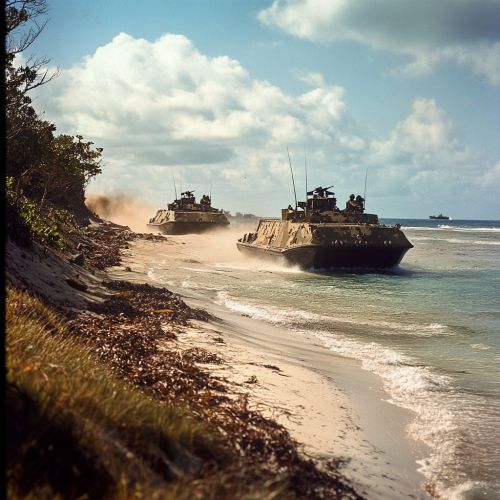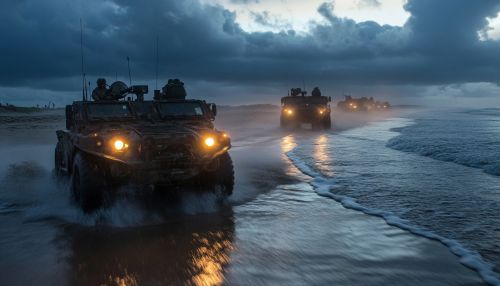Amphibious Warfare: Difference between revisions
(Created page with "== Introduction == Amphibious warfare is a type of military operation that involves the use of naval forces to project ground and air power onto a hostile or potentially hostile shore. This multifaceted form of warfare requires the coordination of land, sea, and air forces to achieve strategic objectives. Amphibious operations are complex and require meticulous planning, specialized equipment, and highly trained personnel. The history of amphibious warfare is rich and v...") |
No edit summary |
||
| Line 39: | Line 39: | ||
In the European Theater, the most famous amphibious operation was the [[D-Day]] invasion of Normandy on June 6, 1944. This operation, codenamed [[Operation Overlord]], involved the largest amphibious assault in history, with over 156,000 Allied troops landing on the beaches of Normandy. The success of D-Day was a turning point in the war and demonstrated the effectiveness of well-coordinated amphibious operations. | In the European Theater, the most famous amphibious operation was the [[D-Day]] invasion of Normandy on June 6, 1944. This operation, codenamed [[Operation Overlord]], involved the largest amphibious assault in history, with over 156,000 Allied troops landing on the beaches of Normandy. The success of D-Day was a turning point in the war and demonstrated the effectiveness of well-coordinated amphibious operations. | ||
[[Image:Detail-98399.jpg|thumb|center|Amphibious assault vehicles approaching a beach during a military exercise.|class=only_on_mobile]] | |||
[[Image:Detail-98400.jpg|thumb|center|Amphibious assault vehicles approaching a beach during a military exercise.|class=only_on_desktop]] | |||
== Post-World War II Developments == | == Post-World War II Developments == | ||
Latest revision as of 08:36, 11 October 2024
Introduction
Amphibious warfare is a type of military operation that involves the use of naval forces to project ground and air power onto a hostile or potentially hostile shore. This multifaceted form of warfare requires the coordination of land, sea, and air forces to achieve strategic objectives. Amphibious operations are complex and require meticulous planning, specialized equipment, and highly trained personnel. The history of amphibious warfare is rich and varied, encompassing a wide range of operations from ancient times to modern conflicts.
Historical Development
Ancient and Medieval Periods
The concept of amphibious warfare can be traced back to ancient times when military forces first utilized the sea as a means of transporting troops to enemy shores. The Greeks and Romans were among the earliest civilizations to conduct amphibious operations. The Greeks, for example, used triremes to transport hoplites across the Aegean Sea during the Peloponnesian War. Similarly, the Romans conducted numerous amphibious assaults during their expansion across the Mediterranean, including the invasion of Britain in 43 AD.
During the medieval period, amphibious warfare continued to evolve. The Vikings were particularly adept at launching raids from the sea, using their longships to strike swiftly and unexpectedly along the coasts of Europe. The Norman Conquest of England in 1066 is another notable example, where William the Conqueror successfully transported his army across the English Channel.
Early Modern Period
The early modern period saw significant advancements in naval technology and tactics, which in turn influenced amphibious warfare. The development of larger, more powerful ships enabled the transportation of larger forces and equipment. The Spanish Armada's attempted invasion of England in 1588 is a well-known example of an amphibious operation during this period, although it ultimately ended in failure.
In the 17th and 18th centuries, European powers frequently engaged in amphibious operations as they vied for control of colonies and trade routes. The British Royal Navy played a crucial role in these operations, using its naval superiority to support landings in North America, the Caribbean, and India.
19th Century
The 19th century saw further developments in amphibious warfare, particularly during the Napoleonic Wars. The British conducted several successful amphibious operations, including the Battle of Aboukir Bay in 1801, where they landed troops to defeat a French force in Egypt. The Crimean War also featured notable amphibious operations, such as the Allied landing at Evpatoria.
The American Civil War marked a turning point in amphibious warfare with the introduction of ironclad ships and the use of combined arms tactics. The Union Army and Navy conducted several successful amphibious assaults, including the capture of Fort Fisher in 1865.
World War I
World War I saw the first large-scale modern amphibious operations, most notably the Gallipoli Campaign in 1915. This campaign aimed to secure a sea route to Russia and knock the Ottoman Empire out of the war. Despite its ambitious goals, the operation was plagued by poor planning and execution, resulting in a costly failure for the Allies. The lessons learned from Gallipoli would later influence the development of amphibious tactics and equipment.
World War II
World War II marked the zenith of amphibious warfare, with numerous large-scale operations conducted across multiple theaters. The Allied forces developed specialized landing craft, such as the Landing Craft, Vehicle, Personnel (LCVP), and amphibious vehicles like the DUKW to facilitate beach landings.
Pacific Theater
In the Pacific Theater, the United States conducted a series of island-hopping campaigns to capture strategic islands from the Japanese. Notable operations include the Battle of Guadalcanal, the Battle of Tarawa, and the Battle of Iwo Jima. These operations required extensive coordination between the U.S. Navy, Marine Corps, and Army to achieve success.
European Theater
In the European Theater, the most famous amphibious operation was the D-Day invasion of Normandy on June 6, 1944. This operation, codenamed Operation Overlord, involved the largest amphibious assault in history, with over 156,000 Allied troops landing on the beaches of Normandy. The success of D-Day was a turning point in the war and demonstrated the effectiveness of well-coordinated amphibious operations.


Post-World War II Developments
Cold War Era
During the Cold War, amphibious warfare continued to evolve as new technologies and doctrines emerged. The development of helicopters and vertical envelopment tactics allowed for more flexible and rapid deployment of forces. The United States Marine Corps (USMC) became a leading proponent of amphibious warfare, refining its capabilities through exercises and operations such as the Inchon Landing during the Korean War.
The Vietnam War also saw the use of amphibious operations, with the USMC conducting numerous riverine and coastal assaults. The introduction of the Landing Platform Dock (LPD) and Landing Helicopter Dock (LHD) ships further enhanced the ability to project power ashore.
Modern Era
In the modern era, amphibious warfare remains a critical component of military strategy. The development of Amphibious Ready Groups (ARG) and Marine Expeditionary Units (MEU) has allowed for rapid response to crises around the world. Advances in technology, such as the MV-22 Osprey and the F-35B Lightning II, have further expanded the capabilities of amphibious forces.
Tactics and Doctrine
Amphibious warfare involves a complex interplay of tactics and doctrine to achieve success. Key elements include:
Planning and Intelligence
Successful amphibious operations require detailed planning and accurate intelligence. Planners must consider factors such as tides, weather, enemy defenses, and logistical support. Intelligence gathering is crucial to identify potential landing sites and enemy strengths and weaknesses.
Command and Control
Effective command and control (C2) is essential for coordinating the various elements of an amphibious operation. Modern C2 systems enable real-time communication and decision-making, allowing commanders to adapt to changing conditions on the battlefield.
Landing and Assault
The landing phase is the most critical and dangerous part of an amphibious operation. Specialized landing craft and vehicles are used to transport troops and equipment from ships to shore. Once ashore, forces must quickly secure the beachhead and advance inland to achieve their objectives.
Logistics and Sustainment
Amphibious operations require robust logistical support to sustain forces ashore. This includes the transportation of supplies, equipment, and reinforcements. The use of pre-positioned stocks and sea basing can enhance the sustainment of amphibious forces.
Equipment and Technology
Amphibious warfare relies on a wide range of specialized equipment and technology to achieve success. Key components include:
Landing Craft and Vehicles
Landing craft and vehicles are essential for transporting troops and equipment from ships to shore. Modern examples include the Landing Craft Air Cushion (LCAC), which can transport heavy loads at high speeds, and the Amphibious Assault Vehicle (AAV), which provides armored protection for troops during the landing phase.
Ships and Platforms
Amphibious ships and platforms serve as the base of operations for amphibious forces. These include amphibious assault ships, which can carry helicopters and vertical takeoff aircraft, and dock landing ships, which support the launch and recovery of landing craft.
Aircraft and UAVs
Aircraft and unmanned aerial vehicles (UAVs) play a crucial role in amphibious operations, providing air support, reconnaissance, and logistics. The integration of UAVs has enhanced situational awareness and target acquisition capabilities.
Challenges and Considerations
Amphibious warfare presents numerous challenges and considerations for military planners and commanders. These include:
Environmental Factors
Environmental factors such as weather, tides, and terrain can significantly impact the success of an amphibious operation. Planners must carefully assess these factors and develop contingency plans to mitigate their effects.
Enemy Defenses
Enemy defenses, including anti-ship missiles, mines, and coastal artillery, pose significant threats to amphibious forces. Suppression and neutralization of these defenses are critical to ensuring a successful landing.
Political and Strategic Considerations
Amphibious operations often have significant political and strategic implications. Planners must consider the potential impact on international relations and the broader geopolitical context.
Future of Amphibious Warfare
The future of amphibious warfare will likely be shaped by emerging technologies and evolving threats. Advances in cyber warfare, artificial intelligence, and autonomous systems have the potential to transform the way amphibious operations are conducted. Additionally, the increasing importance of the Indo-Pacific region and the rise of near-peer competitors will likely drive the continued development and refinement of amphibious capabilities.
